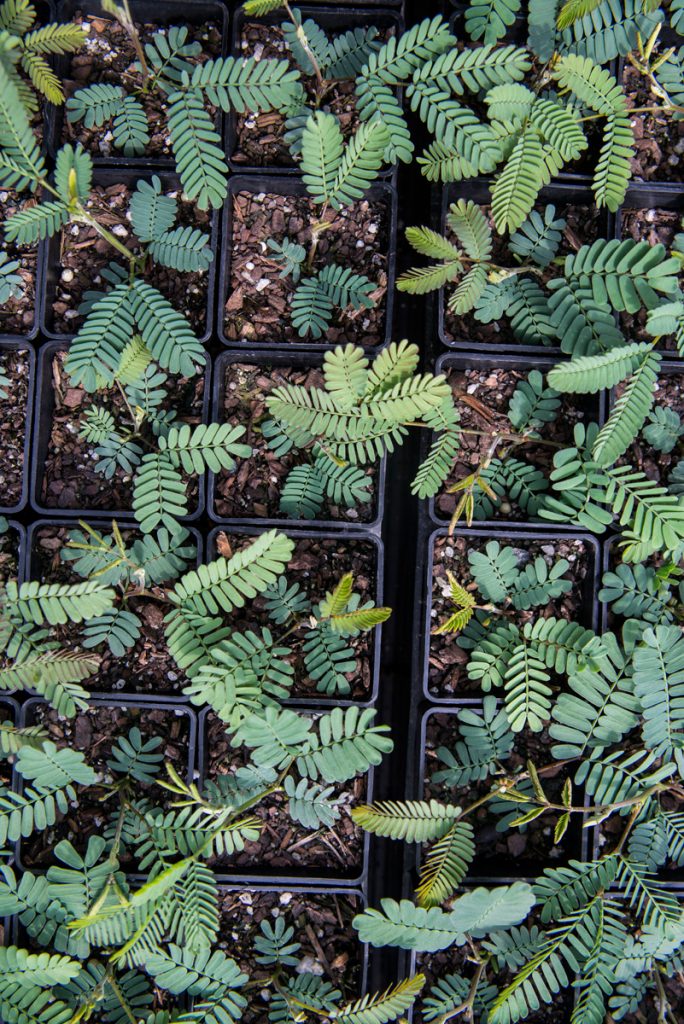Pride of Tassie
The inspirational nursery in Tasmania that has been key to rehabilitating much of the island’s landscape is going strong after 25 years.
As you approach Habitat Plants in Tasmania’s north, you could be forgiven for thinking you’re about to vanish into a mountain. After driving through rich countryside about 40 kilometres from Launceston, you will see a small sign on a fencepost which points you up a narrow, climbing dirt road and into the dark forest canopy. Towering above you are the imposing ramparts of the 1297-metre-high peak of Dry’s Bluff. It could all feel a little foreboding. But press on and you will be rewarded, for visiting
Habitat is just about the antithesis of an experience in a mega hardware store nursery. As you reach the nursery, the forest canopy that enveloped you on your way up the hill opens up to a bright, beautiful site so naturalistic that you may find it difficult to differentiate between the cultivated plants and the native vegetation.
You’re likely to be greeted by the even brighter smile of Sally Staubmann, one half of Habitat. She and her husband Herbert, originally from Austria, have lived beneath Dry’s Bluff since the 1980s and have been growing their Tasmanian native plant business here ever since. Not long after moving to Tasmania, a chance meeting with a horticulture lecturer saw Herbert drop his electrical mechanic’s career to study horticulture.
While working in landscaping in the late 1980s Herbert noticed that most of the shelter-belts on Tasmania’s farms were planted out in exotic radiata pine and he imagined how much better it would be if local natives were also grown to maintain the character of the landscape. Unable to source Tasmanian native plants, Herbert began to cultivate them at their Liffey property.
“I was motivated by the aesthetics of the landscape. I loved eucalypts and still do,” says Herbert.
“This led me to a deeper understanding of the needs of our natural ecosystem. Local creatures need local plants”. Growing and living among native plants also helps you understand your local habitat better according to Herbert. “The better you understand your habitat the more comfortable you are living in it”, he says.
Two and a half decades later, re-vegetation work still accounts for 70 per cent of Habitat’s activities, although there is a much more sophisticated regime in place these days where they work closely with various organisations and land managers on both public and private land, including in many of the island’s national parks.
The European colonization of Tasmania saw extensive broad scale clearing of land across the island, but especially in the rich agricultural land in the north. Many farmers now call in Sally and Herbert, either directly or through federally funded natural resource management bodies, to re-vegetate degraded areas of their properties.
“There’s quite a lot of activity to remedy those past incursions into the landscape”, says Herbert.
Much of this work is concentrated around what’s known as riparian re-vegetation, where drainage and creek lines and river frontages are rehabilitated to improve water quality, maintain ecosystems and re-attract native birds.
“We feel a real sense of pride when we travel Tasmania and see some of our re-veg fully matured,” says Sally. “There are some quite big trees out there now.”
Herbert explains that climate change, however, is adding to the complexity of re-vegetation species selection. “You now need to think ahead more and accept that you may need to choose genetic material adapted to hotter, drier environments,” he says.
Surrounded by large eucalypts and rainforest under-storey below the towering Dry’s Bluff, the Habitat site is undeniably beautiful. Terracing of their nursery areas, separated by bands of native vegetation that attracts birds and frogs means that most visitors to the nursery won’t see the expansive racks of seedlings growing for re-vegetation programs.
Most make the trek out to Habitat for its retail nursery at the bottom of their hill. Established in 2002 to meet a growing demand from gardeners for Tasmanian native plants, and to allow Sally to fully join the business, it is a nursery in a garden in the bush and is a delight to visit.
“Before we opened the retail nursery we had a reputation as the nursery that didn’t want customers, as we weren’t open to the public,” laughs Sally. “We wanted it to be an experience from the beginning and not just another nursery.”
Now into its fourteenth year, their nursery is an inspiring and educational experience for most into the diversity and beauty of Tasmania’s unique flora.
While Sally and Herbert stock only some 200 of the almost 2000 varieties of Tasmanian plants, their range still takes you on a journey from the plants of the plains and coastal heath lands, through to the eucalypt- and rain-forests and possibly Tasmania’s hardiest, but most vulnerable plants, its alpine species.
While many enthusiastic gardeners are tempted to fill their basket with plants from all of Tasmania’s bio-regions, Sally and Herbert work closely with customers to choose plants suitable for their sites.
“We sometimes talk people out of plants unlikely to grow in their area,” says Sally. “We want them to come back and if plants survive they’re more likely to do that.”
In beautiful pots around their racks of mostly tube stock grow larger specimens of rare and endemic Tasmanian plants, including huon pine, pandani, gnarly banksia serrata and the unique fagus (Nothofagus gunnii ), or deciduous beech, Australia’s only winter deciduous tree. Some of these larger plants have been around as long as the retail nursery and while Herbert believes they need to shift more of them, Sally admits that she’s become quite attached.
“Working with plants is just good for your soul,” she says.









